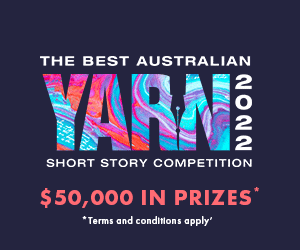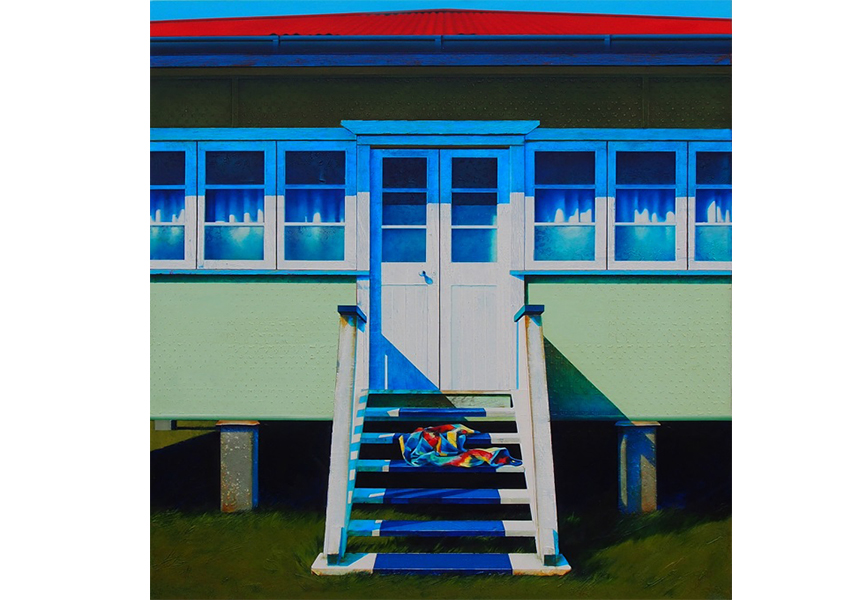PRIZE REVIEW: The Best Australian Yarn 2022

This month, Arts Law has reviewed the terms and conditions of the Best Australia Yarn 2022 (the Competition) in Western Australia. Read the terms and conditions (T&Cs) of this Competition here.
The deadline for this Competition is 31 May 2022.
What is the rating?

Arts Law has awarded the Competition 4 stars out of 5. Read on to find out more detail.
How did Arts Law help?
Arts Law reached out to The West Australian and the Minderoo Foundation (the Organisers) to make this Competition’s T&Cs even more author-friendly. We were delighted that the Organisers were very prompt and willing to discuss our feedback to make the T&Cs clearer and fairer for entrants. The Organisers were appreciative of Arts Law’s suggestions and moved very quickly to make some minor changes to their T&Cs to clarify the copyright licence that entrants provide and to always respect the moral rights of all authors. The deadline to the Competition was fast approaching when Arts Law contacted the Organiser’s, so they were not in a position to address all the suggestions we made but said they are very willing to look at the feedback in more detail for future Competitions.
Overall, Arts Law was impressed with the positive attitude the Organisers took to respecting author’s rights.
How artist-friendly is The Best Australian Yarn 2022?
Overall, this Competition’s terms are friendly for writers but could benefit from a few improvements to gain a 5-star rating, as discussed below.
How do the copyright terms stack up?
Copyright is a bundle of rights that protect literary, artistic, musical and dramatic works (as well as films and sound recordings). These rights allow the owner of copyright to control the ways that a work is used. If you want to learn more, you can read Arts Law’s Information Sheet on Copyright here.
It is great to see that the terms state that all entrants will retain copyright to their story. Entrants should be aware that they are granting permission to the Organisers to use their literary work which will affect their copyright.
By submitting an entry, all entrants will grant the Organisers a 12-month licence to use, distribute, broadcast and sub-license the entry in any way whatsoever (including for commercial purposes) in connection with the Competition. Initially the T&Cs were unclear on the scope of the copyright licence (e.g. exclusive or non-exclusive) but the Organisers have updated them to clarify that between 31 May—31 December 2022, the licence is exclusive. This means that during this period entries must remain unpublished and not be entered to other competitions. Following this, between 1 January—31 May 2023, the licence is non-exclusive. This is good as it means that during this period the writer is free to use their story elsewhere in any way they choose.
Writers who have their work published will have an opportunity to achieve publicity and recognition in the field, however publication of their work is not guaranteed.
For a better rating, we would have liked to have seen that the copyright licence was only granted byto the finalists rather than all entrants. This is because the finalists receive the benefit of winning whereas non-finalists receive no financial benefit by granting the licence. It would be fairer if the entrants who are not finalists, have an opportunity to ‘opt-in’ to their work being published, rather than granting default permission given that:
- if they are not finalists they will not receive a prize, therefore there is nothing to say that they will receive direct financial payment; and
- there is no guarantee their work will be published at all.
Entrants should weigh up the risk of submitting their work to the competition and having it tied up exclusively for 6-months, versus the potential opportunity of having it published by a professional media organisation with high circulation, with no financial payment but a good publicity and profiling opportunity.
Does the Competition respect moral rights?
Creators have moral rights when their work is used (i) to attribution, (ii) against false attribution, and (iii) to integrity, which means not having their work treated in a derogatory way. For more information, you can read Arts Law’s Information Sheet on Moral Rights here.
We are pleased with the Competition’s amendments to acknowledge an author’s moral rights. Prior to reaching out to the Organisers, the T&Cs did not adequately address the treatment of moral rights. Now, the T&Cs include a positive statement that, the Organisers will always credit the author of the work when reproducing the work (except during the judging process, which is a ‘blind’ process for the benefit of entrants)). Regarding the alteration of work, the T&Cs include a term that acknowledges that no changes will be made to the works without first seeking the prior written consent of the author.
This is a great outcome for all authors, ensuring that they are credited for their work and that their work is treated with integrity by allowing no changes to be made without prior consent.
Entries that are selected to be published in The West Australian and The Sunday Times, will have custom illustrations and design treatment. The T&Cs are silent on whether the author would have approval rights. Typically, in the traditional book publishing industry, given that illustrations can inform the context and meaning of the work, the author would be involved in this process. However, given the fast-paced nature of the print/digital news industry this may not be practical in these circumstances. It would be good if it was addressed in the T&Cs whether the author would have the opportunity to provide feedback/approval before the work was published.
What about Indigenous Cultural and Intellectual Property?
Indigenous Cultural and Intellectual Property (ICIP) is a broad term that covers all of the rights that Indigenous people have, and want to have, to protect their traditional arts and culture (including writing, music, performances, paintings, languages, sacred sites, stories passed down orally, and other records of heritage). If you want to learn more, you can read Arts Law’s Information Sheet on ICIP here.
In anticipation that some entrants may submit stories that incorporate Indigenous storytelling, it would be best practice for the T&Cs to address ICIP. Entrants who are incorporating ICIP into their literary work should be required to follow protocols to either warrant they have the appropriate permissions, or to ensure that they consulted and received required permissions from the relevant custodians of the ICIP. Because it isn’t always practical for Competition organisers to develop their own ICIP protocols, another option is to bind entrants to comply with an existing set of protocols used in the sector, such as the ‘Protocols For Using First Nations Cultural And Intellectual Property In The Arts’ (published by the Australia Council for the Arts and accessible online here). Best practice for Competition organisers is to commit to attributing any ICIP as notified by the entrant, and do not publish or use work in a way that is considered degrading or offensive by the Indigenous community.
What could the Best Australian Yarn 2022 have done better?
This Competition offers cash prizes and an opportunity for authors to be published, which is great. To achieve a 5-star rating, Arts Law would have liked to see the organisers:
- Only require the finalists to grant a copyright licence and provide all entrants the option to ‘opt-in’ to granting the licence if they aren’t finalists.
- Acknowledge ICIP in the Ts&Cs and require entrants and the organisers to commit to following best practice protocols when incorporating or publishing material with ICIP.
- Provide further clarity on the illustrations and design treatment by providing the author with a reasonable opportunity to approve the final illustrations that will accompany their literary work before it is published.
Overall, the terms of the Competition are entrant-friendly and Arts Law is pleased that the Organisers took some of our suggestions on board to achieve a higher rating.
You can lodge a query with us here if you would like to obtain advice from Arts Law about this Competition.
What is the Best Australian Yarn 2022 about?
The West Australian and Minderoo Foundation present ‘The Best Australian Yarn’, a fictional short story writing Competition to celebrate creative writing and the arts across Australia.
Entries are open to Australian citizens who are 12 years and over. Entries must be fictional writing, between 1,500 and 2,500 words and any entries outside this word count will not be considered. There are no restrictions on the theme for the Competition, as long as they are original, unpublished and written in English. Entries to the Competition cannot have been published before in any form (this includes print and online).
By entering the Competition, the entrants warrant that their stories are suitable for publication by West Australian Newspapers.
The entries will go through a longlist panel of experienced writers from the West Australian, which will select the best 50 short stories. Those entries will then go to the Prize Jury, who will determine the final shortlist of 10 and the winners of various categories.
What prizes are on offer in the Best Australian Yarn 2022?
There is a prize pool of $50,000 cash-prizes to be won across fourteen prize categories.
The first prize winner will receive a grand prize of $30,000, with the remaining nine shortlisted to receive $1,000 each. The WA Prize, for the best story by a West Australian resident will receive $4,000. The Regional Australian prize, for the best story from an entrant living outside a major city will receive $3,000. The Youth Prize, for entrants aged 12-18, is $2,000 and includes mentoring opportunities curated by The West Australian. Finally, the West Australian’s Readers’ Choice Prize, judged by a public vote, is $2,000
The shortlist will be announced in October 2022 and winners are expected to be announced in November/December 2022.
About
Arts Law regularly reviews the terms and conditions of Competitions and rates them out of five stars. Our review looks broadly at the terms and conditions of a Competition. In particular, we look closely at how a Competition deals with an entrant’s copyright and moral rights and consider this in light of the prize. Entrants should always consider the possible profile-raising which may result from being a finalist or winner.
By accepting the terms and conditions of a Competition, entrants should be aware that they may be entering a legally binding contract.
For more information, see our free information sheet on Competition conditions. Entrants are welcome to contact Arts Law for legal advice on the terms of a Competition. We also invite Competition organisers to contact Arts Law for best practice assistance to make their terms and conditions fairer for entrants.
Please note: Prior to February 2018, Arts Law’s rated out of five stars only the terms of a Competition which dealt with copyright and moral rights. Arts Law’s Competition reviews are now more holistic, such that our rating out of five stars now reflects a broad review of all the terms and conditions of the Competition. For more information see our website.
Further Information
Please email us at [email protected] to tell us about any Competitions or prizes you think we should check.
See more about Arts Law’s campaign to improve Competition terms and conditions in the Prizes and Competitions section.




